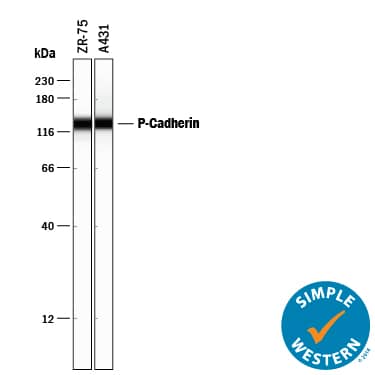Human P-Cadherin Antibody
R&D Systems, part of Bio-Techne | Catalog # AF861


Key Product Details
Species Reactivity
Validated:
Cited:
Applications
Validated:
Cited:
Label
Antibody Source
Product Specifications
Immunogen
Asp108-Gly654
Accession # CAA45177
Specificity
Clonality
Host
Isotype
Scientific Data Images for Human P-Cadherin Antibody
Detection of Human P‑Cadherin by Western Blot.
Western blot shows lysate of ZR-75 human breast cancer cell line. PVDF membrane was probed with 1 µg/mL of Goat Anti-Human P-Cadherin Antigen Affinity-purified Polyclonal Antibody (Catalog # AF861) followed by HRP-conjugated Anti-Goat IgG Secondary Antibody (Catalog # HAF017). A specific band was detected for P-Cadherin at approximately 120 kDa (as indicated). This experiment was conducted under reducing conditions and using Immunoblot Buffer Group 1.Detection of Human P‑Cadherin by Simple WesternTM.
Simple Western lane view shows lysates of ZR-75 human breast cancer cell line and A431 human epithelial carcinoma cell line, loaded at 0.2 mg/mL. A specific band was detected for P-Cadherin at approximately 135 kDa (as indicated) using 10 µg/mL of Goat Anti-Human P-Cadherin Antigen Affinity-purified Polyclonal Antibody (Catalog # AF861) followed by 1:50 dilution of HRP-conjugated Anti-Goat IgG Secondary Antibody (Catalog # HAF109). This experiment was conducted under reducing conditions and using the 12-230 kDa separation system.Applications for Human P-Cadherin Antibody
CyTOF-ready
Flow Cytometry
Sample: A431 human epithelial carcinoma cell line
Simple Western
Sample: ZR‑75 human breast cancer cell line and A431 human epithelial carcinoma cell line
Western Blot
Sample: ZR‑75 human breast cancer cell line
Formulation, Preparation, and Storage
Purification
Reconstitution
Formulation
Shipping
Stability & Storage
- 12 months from date of receipt, -20 to -70 °C as supplied.
- 1 month, 2 to 8 °C under sterile conditions after reconstitution.
- 6 months, -20 to -70 °C under sterile conditions after reconstitution.
Background: P-Cadherin
Placental (P)-Cadherin (PCAD) is a member of the Cadherin family of cell adhesion molecules. Cadherins are calcium-dependent transmembrane proteins, which bind to one another in a homophilic manner. On their cytoplasmic side, they associate with the three catenins, alpha, beta, and gamma (plakoglobin). This association links the cadherin protein to the cytoskeleton. Without association with the catenins, the cadherins are non-adhesive. Cadherins play a role in development, specifically in tissue formation. They may also help to maintain tissue architecture in the adult. P-Cadherin is a classical cadherin molecule. Classical cadherins consist of a large extracellular domain which contains DXD and DXNDN repeats responsible for mediating calcium-dependent adhesion, a single-pass transmembrane domain, and a short carboxy-terminal cytoplasmic domain responsible for interacting with the catenins. Human P-Cadherin is an 829 amino acid (aa) protein with a 26 aa signal sequence and an 803 aa propeptide. The mature protein begins at aa 108 and has a 548 aa extracellular region, a 23 aa transmembrane region, and a 151 aa cytoplasmic region. The human and mouse mature PCAD proteins share 87% homology.
References
- Shimoyama, Y. et al. (1989) J. Cell Biol. 109:1787.
- Bussemakers, M.J.G. et al. (1993) Mol. Biol. Reports 17:123.
- Overduin, M. et al. (1995) Science 267:386.
- Takeichi, M. (1991) Science 251:1451.
- Nose, A. et al. (1987) EMBO J. 6:3655.
Long Name
Alternate Names
Gene Symbol
UniProt
Additional P-Cadherin Products
Product Documents for Human P-Cadherin Antibody
Product Specific Notices for Human P-Cadherin Antibody
For research use only
